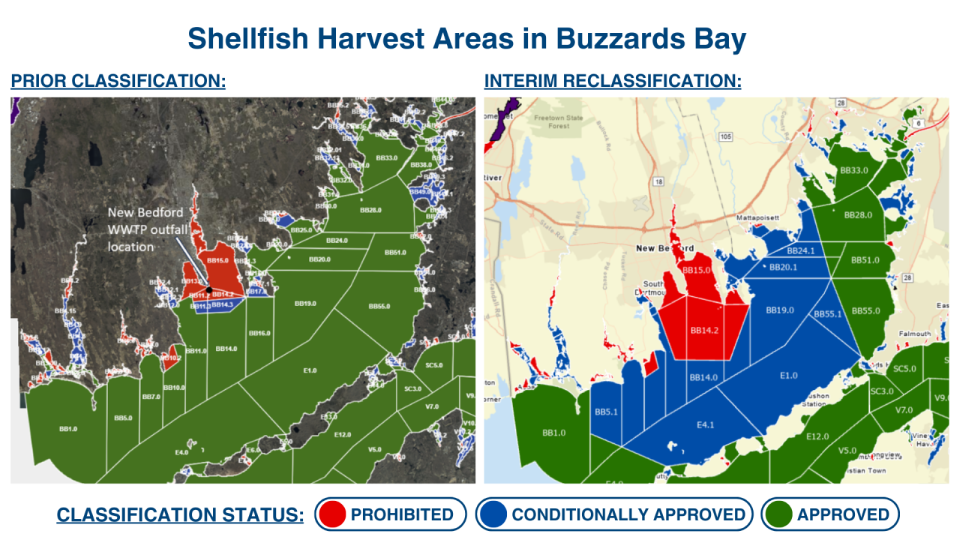Shellfishing in New Bedford Harbor to be further limited due to overflow from plant
NEW BEDFORD — An additional 11,310 acres of New Bedford Harbor has been closed to shellfishing by the Department of Fish & Game’sDivision of Marine Fisheries to safeguard public health.
Previously, 6,901 acres of New Bedford Harbor was closed to shellfishing due to outfall from the New Bedford and Fairhaven Wastewater Treatment Plant in order to comply with national standards.
An interim reclassification plan, effective immediately, takes necessary measures to protect shellfish consumers while minimizing impacts to historic aquaculture businesses, commercial shellfishing, and recreational shellfishing, according to a press release.

To avoid a widespread closure, DMF has opted to pursue the interim plan that expands the “prohibited” safety zone around the wastewater treatment outfalls by another 11,310 acres instead.
The interim plan also reclassifies surrounding areas in Buzzards Bay as “conditionally approved” or open to harvest except under emergency conditions like sewage overflows.
Why is closure necessary?
In the release, Division of Marine Fisheries Director Dan McKiernan said that robust monitoring of shellfish throughout Buzzards Bay to fully understand the impacts of wastewater treatment plant discharges.
“This interim reclassification plan, necessary to sustain commercial shellfishing and interstate commerce, maximizes access to shellfishing opportunities under current regulations and preserves aquaculture operations that are important to the region,” he said.
Additionally, Department of Fish & Game Commissioner Tom O’Shea said closing additional areas to shellfishing is necessary to comply with national standards and protect consumers from real public health risks.
“We look forward to working closely with the City of New Bedford, New Bedford and Fairhaven Wastewater Treatment Plant operators, and the shellfishing community to overcome these challenges and ensure high quality shellfish are grown in Buzzards Bay for generations to come,” he said.
What are the classifications?
There are five classifications used in Massachusetts: approved, conditionally approved, restricted, conditionally restricted and prohibited.
These classifications determine whether shellfish in a specific area can be harvested for human consumption.
In these areas, according to the release, DMF will expand water quality monitoring and bacterial and viral testing of shellfish tissue to further understand impacts of wastewater treatment plant discharges on shellfish safety and interpret initial modeling results.
What if the results are in question?
If DMF finds issues with bacterial and viral contamination in waters and the shellfish tested, further areas could be reclassified.
DMF must comply with National Shellfish Sanitation Program standards and is conducting analysis using the best available modeling to reclassify areas surrounding wastewater treatment outfalls statewide.
Preliminary modeling results found that over 103,000 acres of Buzzards Bay could need to be reclassified as “prohibited” to comply with current NSSP guidance standards.
Standard-Times staff writer Kathryn Gallerani can be reached at kgallerani@gannett.com. Follow her on Twitter: @kgallreporter. Support local journalism by purchasing a digital or print subscription to The Standard-Times today.
This article originally appeared on Standard-Times: The interim reclassification plan calls for further closure

